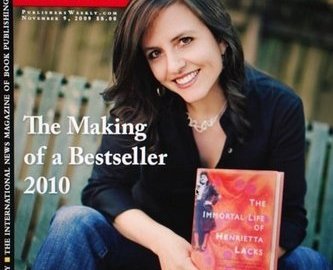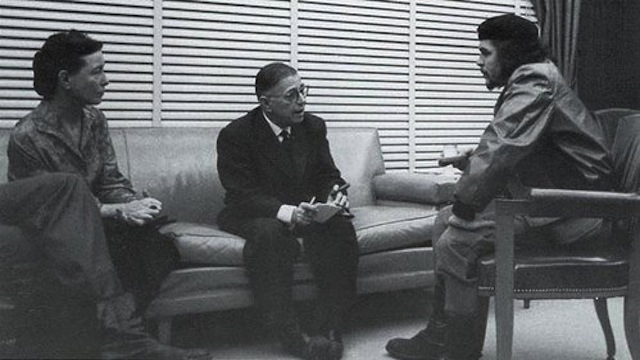BMC Medical Ethics Study Evaluates the Media Impact of Rebecca Skloot’s Immortal Life of Henrietta Lacks

In a new study at the journal BMC Medical Ethics, my colleague Declan Fahy and I analyze the journalistic and critical reception of Rebecca Skloot’s 2010 best-selling book The Immortal Life of Henrietta Lacks, focusing on the implications for public understanding and engagement on issues related to tissue donation, research and biobanking.
The global expansion of biobanks has led to a range of bioethical concerns related to consent, privacy, control, ownership, and disclosure. As an opportunity to engage broader audiences on these concerns, bioethicists have welcomed the commercial success of Skloot’s critically-acclaimed book.
Most biobanks today collect finite amounts of tissue, very few of which are made into “immortal” cell lines as was the case with the HeLa cells documented in Skloot’s book. In addition, many biobanks do not use tissues removed during medical procedures, as was the case with Henrietta Lacks. Yet the story presented by Skloot had the potential to generate a broader discussion in the media and among the public about the ethical concerns related to biobanks and tissue research, a discussion that Skloot admirably attempted to generate in media interviews, in the afterward to her book, and in prominent freelance articles.
Best-selling authors and journalistic commentators like Skloot “provide not only the facts but also the formats, norms, and rhetorics that citizens employ to develop their opinions and enter wider discussion,” conclude sociologists Ronald Jacobs and Eleanor Townsley in their recent book The Space of Opinion: Media Intellectuals and the Public Sphere. “Studying who these communicators are and what cultural practices they use in their debates is just as important as identifying the range of relevant facts that news media do or do not provide.” Similarly, several decades of research in communication and related social science fields has emphasized the unique influence that journalists can have in framing the relevance of complex, science-related subjects and in shaping public judgments and decisions about why an issue might be a problem, who or what is responsible and what should be done.
Given the importance of the media to how the broader public understands the nature of bioethics and biobanks specifically, along with the special role that best-selling science authors and communicators like Skloot can play in reaching wider audiences and stimulating media debate, the purpose of our study was to systematically evaluate the ethical themes emphasized in reviews, profiles, commentaries, stories and features specific to Skloot’s book.
Below is the abstract to the study summarizing our methods and findings and an early version is available open-access online. Following the abstract is the discussion and conclusion to the study.
On Twitter, Skloot has already started a welcome discussion of the study, the nature of media coverage and the broader impact for the book. As we do in the study, Skloot notes that besides media coverage, many classroom, campus and other public forum discussions of the book have taken place, and these discussions are also important to analyze and evaluate in future research. Moreover, as she notes and we emphasize in the study, journalists and reviewers often missed the chance to offer a broader look at the range of issues involved in tissue research, donation and biobanks more generally.
Nisbet, M., & Fahy, D. (2013). Bioethics in popular science: evaluating the media impact of The Immortal Life of Henrietta Lacks on the biobank debate. BMC Medical Ethics, 14 (1) DOI: 10.1186/1472-6939-14-10
ABSTRACT
Background
The global expansion of biobanks has led to a range of bioethical concerns related to consent, privacy, control, ownership, and disclosure. As an opportunity to engage broader audiences on these concerns, bioethicists have welcomed the commercial success of Rebecca Skloot’s 2010 bestselling book The Immortal Life of Henrietta Lacks. To assess the impact of the book on discussion within the media and popular culture more generally, we systematically analyzed the ethics-related themes emphasized in reviews and articles about the book, and in interviews and profiles of Skloot.
Methods
We conducted a content analysis of a population of relevant English-language articles and transcripts (n = 125) produced by news organizations and publications in the U.S., Canada, Great Britain/Ireland, and Australia/New Zealand. We scored each article for the emphasis and appearance of 9 ethics-related themes. These were informed consent, welfare of the vulnerable, compensation, scientific progress, control/access, accountability/oversight, privacy, public education, and advocacy.
Results
The informed consent theme dominated media discussion, with almost 39.2 percent of articles/transcripts featuring the theme as a major focus and 44.8 percent emphasizing the theme as a minor focus. Other prominent themes and frames of reference focused on the welfare of the vulnerable (18.4 percent major emphasis; 36.0 percent minor emphasis), and donor compensation (19.2 percent major; 52.8 percent minor). Ethical themes that comprised a second tier of prominence included those of scientific progress, control/access, and accountability/oversight. The least prominent themes were privacy, public education, and advocacy.
Conclusions
The book has been praised as an opportunity to elevate public discussion of bioethics, but such claims should be re-considered. The relatively narrow focus on informed consent in the media discussion generated by Skloot’s book may limit the ability of ethicists and advocates to elevate attention to donor control, compensation, patenting, privacy, and other ethical issues. Still, ethicists should view the book and a pending major TV film translation as opportunities to highlight through media outreach, consultation exercises and public forums a broader range of bioethical concerns that would otherwise be under-emphasized in news coverage. Such efforts, however, need to be carefully planned and evaluated.
***
BMC Medical Ethics is an open access, peer-reviewed journal that considers articles in relation to the ethical aspects of biomedical research and clinical practice, including professional choices and conduct, medical technologies, healthcare systems and health policies. The study is part of a special series of papers that relate to the University of Alberta’s Health Law and Policy Science Group organized workshop on “Using and Abusing Evidence in Science and Health Policy,” held June 2012 in Banff, Alberta. Other studies to date appear at BMC Medical Ethics, BMC Public Health, and BMC Medicine. The series editor is Timothy Caulfield, Canada Research Chair in Health Law and Policy at the University of Alberta.
FROM THE CONCLUSION TO THE STUDY:
Our analysis indicates that media reviews, profiles, and stories reflected the major ethical themes emphasized by Skloot in her book and publicity efforts. These included an overwhelming focus on issues related to informed consent, the welfare of the vulnerable, the treatment of individuals as people rather than mere subjects, and considerations of compensation and profit sharing. Less frequently emphasized themes included discussion of the conditions under which the need for scientific progress should outweigh other ethical concerns, the control that donors might have over their specimens, the balance between patenting and access to research, and accountability or oversight relative to current policies and procedures. Rarely mentioned or emphasized were considerations related to donor privacy and access to research results, to public education, or to the role of advocacy and activism.
Relative to understanding the direct impact of Skloot’s book on public judgments, our findings should be interpreted cautiously. Our study identified the range of arguments and themes that were most readily available via the media for the public to draw upon in forming opinions and making decisions. These findings, however, should be paired with direct audience research employing surveys, focus groups, in depth interviews and other methods. In coding the results of open-ended surveys, however, the typology of themes that we developed can be usefully applied. The coding scheme can also be used in future research related to media coverage and policy discourse specific to biobanks, including the type of discourse that takes place at public meetings and events. Given the nature of our study, it is also not possible to say with confidence if Skloot’s book was the principal driver of the focus on informed consent in reviews, profiles, news stories, and opinion articles.
Journalists and reviewers are not only influenced by the content of the book (and related publicity materials), but also by broader cultural and political discourses about biomedical research. Yet regardless of the factors ultimately responsible for the strong emphasis on informed consent, the narrow focus may in fact limit the ability of ethicists and advocates to elevate attention to donor control, compensation, patenting, privacy, and other ethical issues. In this regard, even though some scientists have voiced concerns that Skloot’s book might disrupt current policy arrangements specific to tissue donation and research, our findings suggest that the book may in fact serve to reinforce them.
There are other important implications for the journalistic treatment and communication of bioethics to the broader public. First, in contrast to the emphasis that has been placed on public education to ensure broader participation and enrollment in biobanks, media discussion of the book involves little to no emphasis on a role for the public. This may be in line with a view of the book by journalists and reviewers as mainly a cultural commodity and entertainment product to be reviewed, rather than an important opportunity to discuss biomedicine more broadly. Skloot herself has been acclaimed as a model of marketing and self-promotion, and media discourse for the most part characterizes the public as spectators and consumers rather than as active participants in an emerging policy debate. Similarly, because discussion of the book occurred largely in reviews, author interviews and profiles, the book has yet to serve as a catalyst for in depth news coverage of biobanks and related issues. Extended public radio interviews, however, did allow for richer discussions of bioethics than were featured in the arts and culture section of other news organizations.
The greater attention in opinion articles to ethical themes related to control, access, and patenting suggests that opinion writers and editors more so than other journalists viewed it as their role to use Skloot’s book as an opportunity to raise a broader set of ethical questions. These types of discussions have the potential to contribute to public understanding of the complex ethical issues related to biobanking, especially as there is a lack of consensus on these questions, including the meaning of consent, among both the public and experts [39]. Yet despite this potential, the book has yet to prompt journalistic investigations of informed consent policies and practices, has resulted in very few backgrounders on the ethical and policy issues involved, and has generated little attention to the global growth of biobanks specifically. The best-seller has been hailed as an opportunity to elevate discussion of bioethics in the media more generally, but the failure so far to catalyze these types of stories – along with the narrow framing of ethical issues featured in coverage of the book – suggest that such claims should be re-considered.
Finally, the success of the book should demonstrate to bioethicists and scientists that there is an intense public appetite for compelling narratives about advances in medical research and the ethical issues involved. As has been done in some university reading initiatives, the book’s popularity can serve as the starting point for community dialogue and discussion of a broader and more diverse set of ethical themes and frames of reference. With a major HBO film expected, the film may further widen the scope of public interest and the opportunity for engagement. Such efforts, however, need to be carefully planned and evaluated. Ethicists, scientists, and others should view subsequent media manifestations of the book as opportunities to highlight bioethical issues that would otherwise be under-emphasized in news coverage, commentaries, and reviews.





